The NVIDIA GeForce GTX 980 Ti Review
by Ryan Smith on May 31, 2015 6:00 PM ESTOverclocking
Finally, no review of a high-end video card would be complete without a look at overclocking performance.
From a design standpoint, GTX 980 Ti already ships close to its power limits. NVIDIA’s 250W TDP can only be raised another 10% – to 275W – meaning that in TDP limited scenarios there’s not much headroom to play with. On the other hand with the stock voltage being relatively low, in clockspeed limited scenarios there’s still some room for pushing the performance envelope through overvolting. And neither of these options addresses the most potent aspect of overclocking, which is pushing the entire clockspeed curve higher at the same voltages by increasing the clockspeed offsets.
GTX Titan X by comparison ended up being a good overclocker, and while we'd expect GTX 980 Tis to use slightly lower quality chips as part of the binning process, it should still overclock rather well.
| GeForce GTX 980 Ti Overclocking | ||||
| Stock | Overclocked | |||
| Core Clock | 1000MHz | 1250MHz | ||
| Boost Clock | 1075Mhz | 1326MHz | ||
| Max Boost Clock | 1202MHz | 1477MHz | ||
| Memory Clock | 7GHz | 8GHz | ||
| Max Voltage | 1.187v | 1.23v | ||
Overall we're able to get another 250MHz (25%) out of the GTX 980 Ti's GPU, and another 1GHz (14%) out of its VRAM. This pushes the GTX 980 Ti's clockspeeds up to 1326MHz for the standard boost clock, and 1477MHz for the maximum boost clock. The card is heavily TDP limited at this point, so it's unlikely to sustain clockspeeds over 1400MHz, but working clockspeeds in the 1300MHz range are certainly sustainable. Meanwhile interestingly enough, this is actually a slightly better overclock than what we saw with the GTX Titan X; the Titan was only able to get another 200MHz out of its GPU and 800MHz out of its memory. So GTX 980 Ti ends up being the better overclocker by 50MHz.
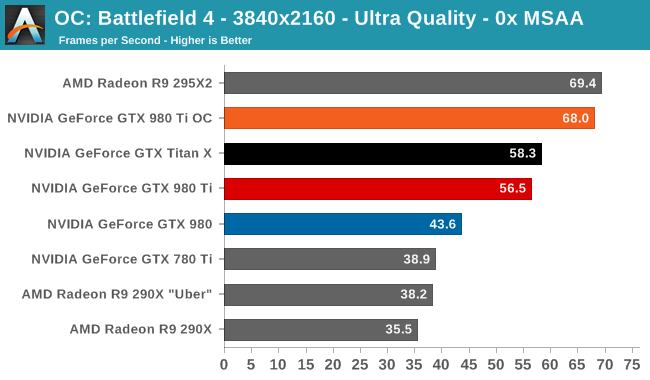
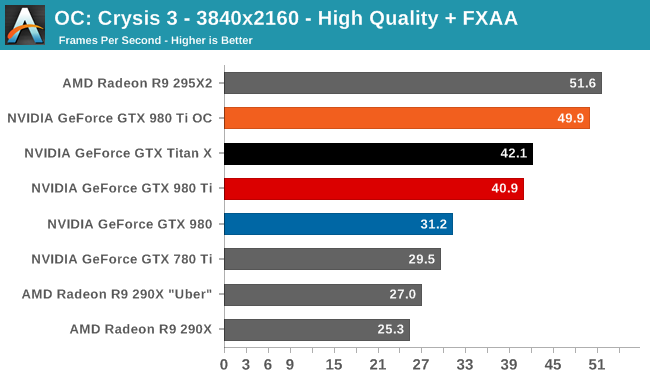
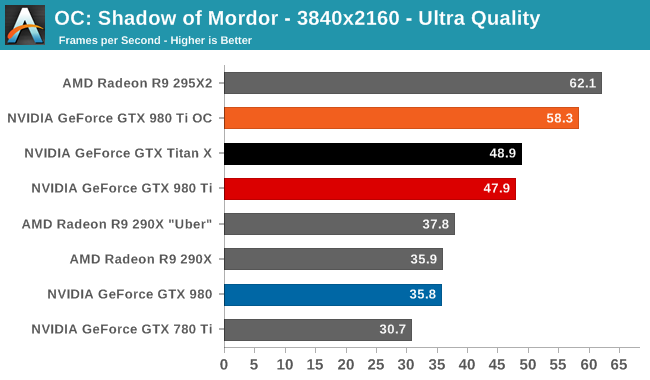
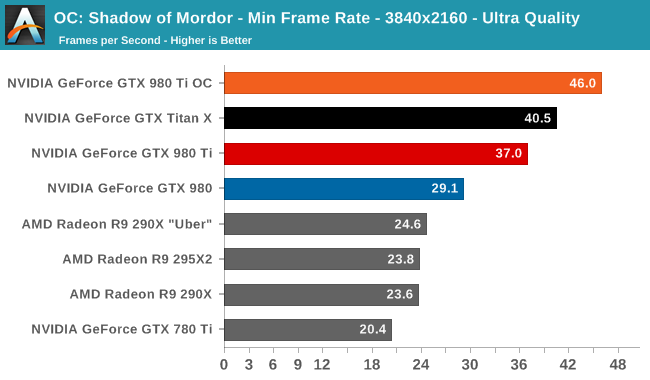
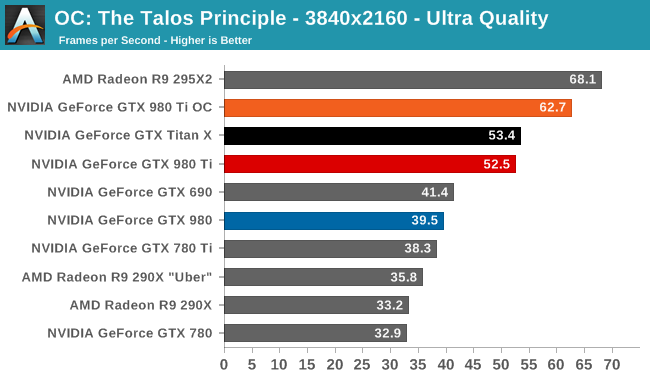
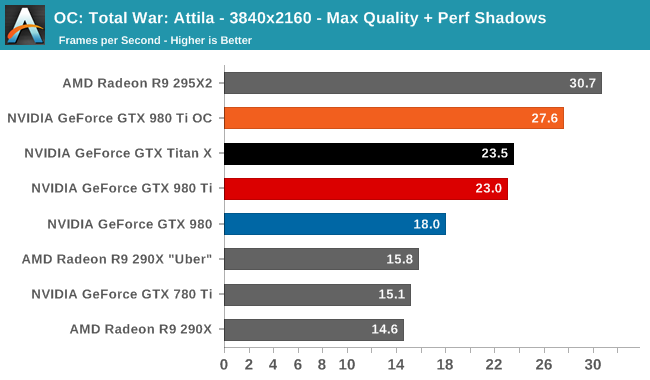
The gains from this overclock are a very consistent across all 5 of our sample games at 4K, with the average performance increase being 20%. Though not quite enough to push the GTX 980 Ti above 60fps in Shadow of Mordor or Crysis 3, it is enough to crack 60fps on Battlefield 4 and The Talos Principle.
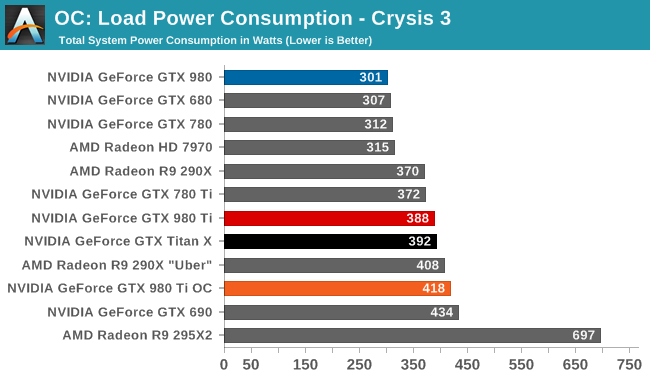
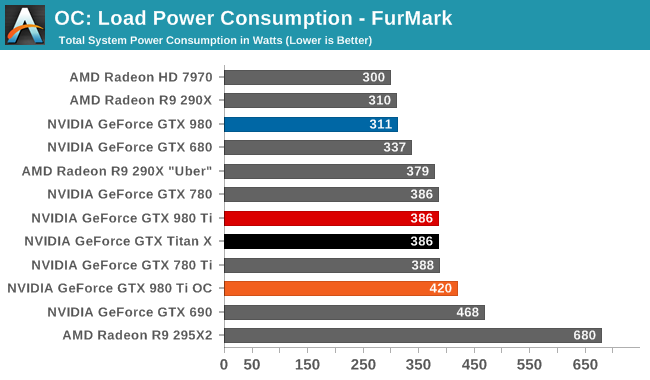
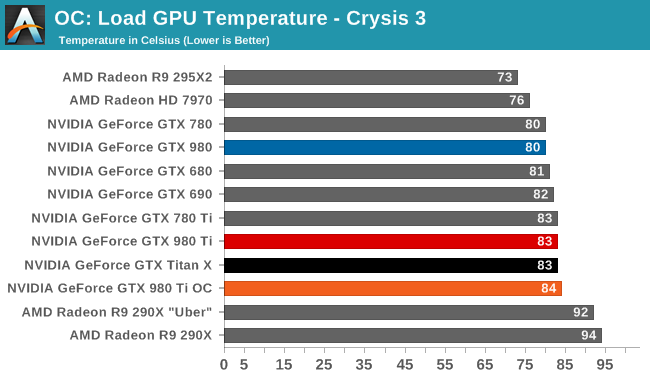
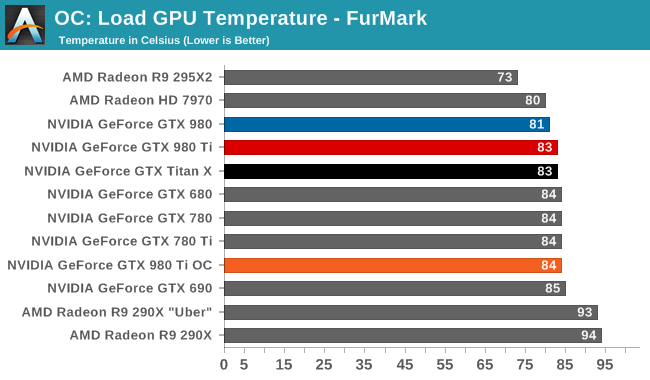
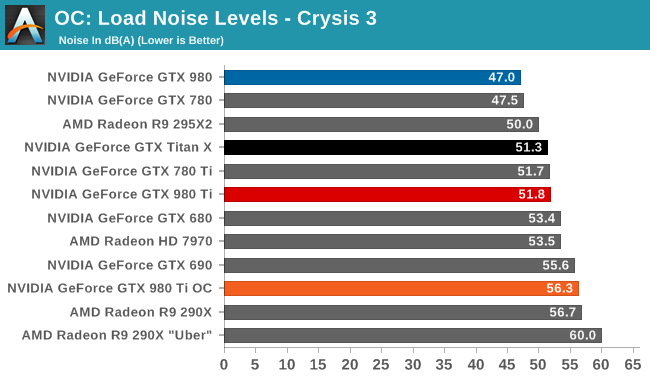
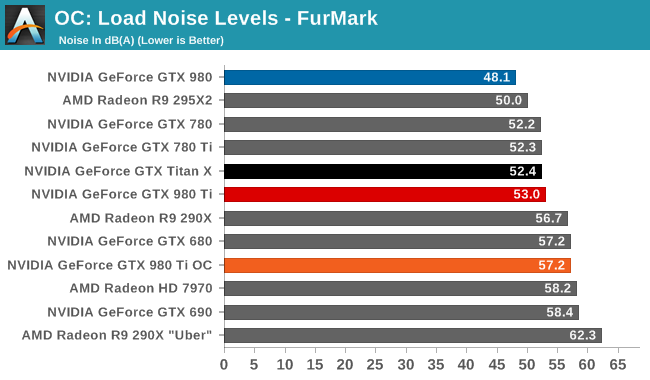
The cost of that 20% overclock in terms of power and noise is similarly straightforward. You're looking at an increased power cost of 30W or so at the wall – in-line with the 25W increase in the card’s TDP – while on the noise front the GTX 980 Ti is pushed out of its sweet spot. Card noise levels will increase by around 4.5dB(A).










290 Comments
View All Comments
Oxford Guy - Monday, June 1, 2015 - link
I'm sure you posted that from your 65nm processor and 80nm GPU.godrilla - Thursday, June 4, 2015 - link
Because next shrink is in the 3d chips plus hbm category and that should be amazing performance leap.Gastec - Sunday, September 4, 2016 - link
Oh yeah, that's "1337 5p34k" for ya! :PWreckage - Sunday, May 31, 2015 - link
Wait until AMD tries to sell you a rebadge for that much.Rezurecta - Sunday, May 31, 2015 - link
I don't understand the rage about rebadge all of a sudden. GPU has been doing this for YEARS!Anyway, nice card from Nvidia for a decent price.
dragonsqrrl - Sunday, May 31, 2015 - link
Don't mix up traditional rebadging and what AMD is doing with their upcoming lineup, it's unprecedented. It's also worrisome, and it's clearly a big problem for AMD. What does it say about the state of the company and their R&D budget that they'll only have 1 new GPU this coming generation? One of the big problems AMD is currently facing, amongst many other things, are their profit margins. In order to compete they're selling larger, more expensive GPU's attached to more complex memory interfaces relative to the competition, and that won't change much this coming generation as a result of these top to bottom rebadges. The situation is really becoming quite analogous to their CPU's, which should raise alarms for any informed enthusiast. It's a less than ideal situation, to put it lightly.Azix - Sunday, May 31, 2015 - link
If you post this after their launch then maybe I'd understand. As it is their Chips are almost certainly not rebadged because they aren't on TSMC and will include hardware improvements. They maybe be based on hawaii or w/e but not even nvidia managed to put out more than 2 new cards during their major launch last year. Considering this is likely the last year of 28nm launches, it may make sense for them to put out an entire line of modified chips and be done with the 300 series. Keeping it fresh till next year when they can do 2-3 on a smaller process.dragonsqrrl - Sunday, May 31, 2015 - link
"If you post this after their launch then maybe I'd understand."You realize I could just give the exact same response to the rest of your comment. But I won't.
"As it is their Chips are almost certainly not rebadged because they aren't on TSMC and will include hardware improvements.",
That's interesting, I haven't heard anything about AMD switching fabs for the 300 series. Source?
"They maybe be based on hawaii or w/e but not even nvidia managed to put out more than 2 new cards during their major launch last year."
Not quite a straight comparison there, since Nvidia also launched a new architecture with the 750Ti. Thus far we've gotten 4 new GPU's (not just cards) based on Maxwell. And we're not just talking launch here. All indications point to Fiji as the only new GPU of the coming generation for AMD. And what's more, it might not even be an updated architecture. The rest of the lineup will likely be refreshes of Hawaii, Tonga, Pitcairn, and Bonaire, ranging from GCN 1.2-1.0, with at most manufacturing revisions to improve efficiency. Again it's very important to put this in perspective, in the context of what these GPU's will be competing against. They range in feature set, and in power efficiency, none of which is anywhere close to par with Maxwell, and it's going to be very difficult for AMD to compete with this lineup for another generation. It's not a good situation for AMD. "Keeping it fresh"? How you came to spin your conclusion the way you did is beyond me.
ImSpartacus - Monday, June 1, 2015 - link
Be nice. The guy is basically telling you at this point.ImSpartacus - Monday, June 1, 2015 - link
trolling***